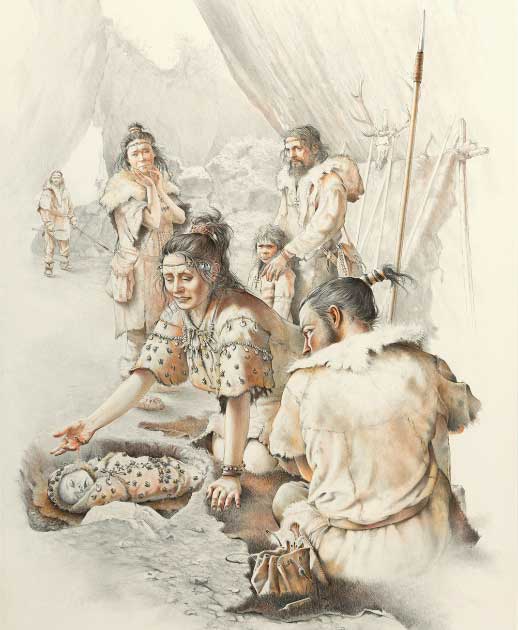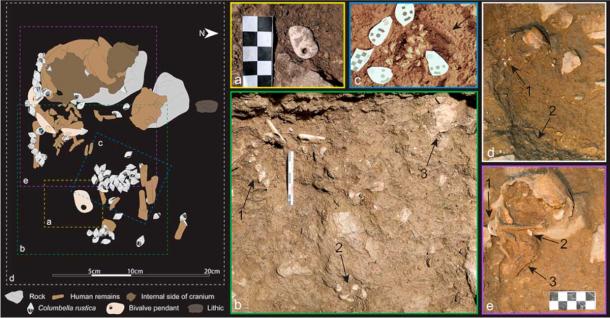
Baby Slings Were a Thing 10,000 Years Ago, New Discovery Reveals
A team of archaeologists have studied the remains of a 10,000-year-old baby with high technology. Their new paper not only found signs of ritual burial, but it reveals that baby carriers, or baby slings, were in use at the end of the last Ice Age.
In December last year Ancient Origins reported on a study published in Scientific Reports conducted by team of Italian archaeologists and paleoanthropologists studying Neve, a 10,000-years-old baby girl’s skeleton. Discovered at the cave site of Arma Veirana in Liguria, northwestern Italy, the baby was buried with over 70 pierced shell beads, four shell pendants and an eagle-owl talon. These grave goods suggested she has been treated very carefully after dying, if not ritually buried.
- Proof Infants Sipped Animal Milk From Prehistoric Baby Bottles
- Stone Age Grave of a Mother and Child is the Oldest Baby Burial in the Netherlands
Now, another team of scientists from Université de Montréal has looked closer at the baby’s remains and the surrounding shells and beads. Not only did they find evidence of a burial ritual, but CT scans of the beads and shells led them to conclude that “baby carriers” were being used at the end of the last ice age.

The ancient baby sling was found at the Arma Vierana cave in northern Italy where the Mesolithic infant and her shell beads were found by the research team. (Jamie Hodgkins / University of Colorado Denver)
The Rarity of Baby Remains in Archaeology
Of course, or obviously, mothers have carried their young since the dawn of human evolution. But because the natural materials that were used to make baby slings have rotted away, archaeology is void of such devices. This means that up until now all theories as to how babies were transported back of forth were pure speculation.
Because baby burials are so exceptionally rare, archaeology stood still in 2018 when the 6,000-year-old remains of a baby were discovered in the Netherlands. Cradled in the arm of the woman believed to be its mother, this baby was probably newborn and certainly no older than six months old. However, the latest study focuses on a baby that was buried all on its own and it demonstrates how babies were cared for by prehistoric communities.

Artistic reconstruction of the Arma Veirana burial. On studying remains, experts have concluded that they provide evidence of the use of an ancient baby sling. (Mauro Cutrona / CC BY 4.0)
The First Evidence of Baby Carrying
The world's oldest known child was discovered in 2020 in north Ethiopia's badlands along the Great Rift Valley, in East Africa. The 3-year-old skeleton dated back 3.3 million years and belonged to the primitive human species Australopithecus afarensis. A National Geographic article about this find claimed it was arguably “more important” than Lucy, the early australopithecine dated to about 3.2 million years ago discovered in Hadar, Ethiopia.
The new study was published in the Journal of Archaeological Method and Theory by Professor Claudine Gravel-Miguel, an Arizona State University (ASU) anthropologist working at the lab of UdeM anthropology professor Julien Riel-Salvatore. The paper presented the first evidence of “baby carrying” and explains how children were socially associated with their surrounding communities .

Field photographs depicting the baby sling ornaments as they were excavated in the ritual baby burial. (Journal of Archaeological Method and Theory / CC BY 4.0)
Guarding Babies from Evil?
In the new study Dr. Gravel-Miguel describes how the team created a high-definition 3D photogrammetry model of the baby’s burial site at the Arma Veirana Cave in Italy. MicroCT scans of the 70 plus beads and shells revealed the perforated marine shells, and four big perforated bivalve pendants, had been “sewn onto leather or cloth and wrapped around Neve” for her burial.
- Dead Baby Burial Vessels, Or Catchers Of The Rain? You Decide
- Roman Baby Burial Challenges “Unceremonious Disposal” Dogma
Further analysis of the beads showed that most of them had been “heavily used,” way beyond what would occur naturally during Neve's 50 or 60 days of life. The last observation suggests someone else in the community had worn the beads and shells before they were used for Neve's burial wrap.
The researchers concluded that the beads and pendants “likely adorned Neve's carrier, which was buried with her.” The cloth or leathers withered away a long time ago leaving only the beads and shells as evidence of an ancient baby sling. The scientists speculate that perhaps the beads were considered to be some form of magical amulet, possibly thought of as protecting wearers against the “negative forces of evil.”
Top image: Mother with baby in a baby sling. Source: sandsun / Adobe Stock
By Ashley Cowie
















Comments
We should expect that the ancients were JUST LIKE US in most ways, and so mothers carried their babies like many do today. But what they looked like shouldn’t be influenced by ‘artistic’ representations. Let’s clone their DNA and find out the truth of who they were.
Nobody gets paid to tell the truth.